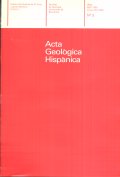Mineralogía de los arenales costeros del litoral catalán: Sant Feliu de Guíxols-Portbou
Abstract
Carbonate is commonly present in small quantity and only it’s percentage is higher, when it can be related to carbonate rocks cropping out in the coast and with the river Ter alluvions. Quartz is the most abundant mineral in the light fraction and it is concentrated in the smaller size. .Plagioclase is dominant over potassic feldspars near granodioritic outcrops and in the south of the river Ter mouth, which has basic rocks in the drainage basin. Potassic feldspars are more frequent in the north of the coast related to the acid rocks of the area; and in the massif of Begur with granitic outcrops. The heavy minerals of north Catalonia coastal sand have diferent sources: the volcanic rocks from Olot, the metamorphic and granitic rocks from the Pyrenees and Coastal Ranges. From Olot basaltic rocks come the basic association olivine and augite. The proportion of olivine is substantially higher than the augite in spite of the higher alterability of the former one. The metamorphic association with andalusite, and sometimes sillimanite and staurolite come from the river Ter basin in the Pyrenees and the coastal rocks and the association formed by hornblende, epidote and apatite can have two origins the coastal rocks, and the sediments of the river Muga from the gulf of Rosas. Andalusite is the most frequent mineral except in the samples from beaches with granitic outcrops. In the North Catalonian coast there is an important granulometric selection in the distribution of heavy minerals which modify the relationship among them.


